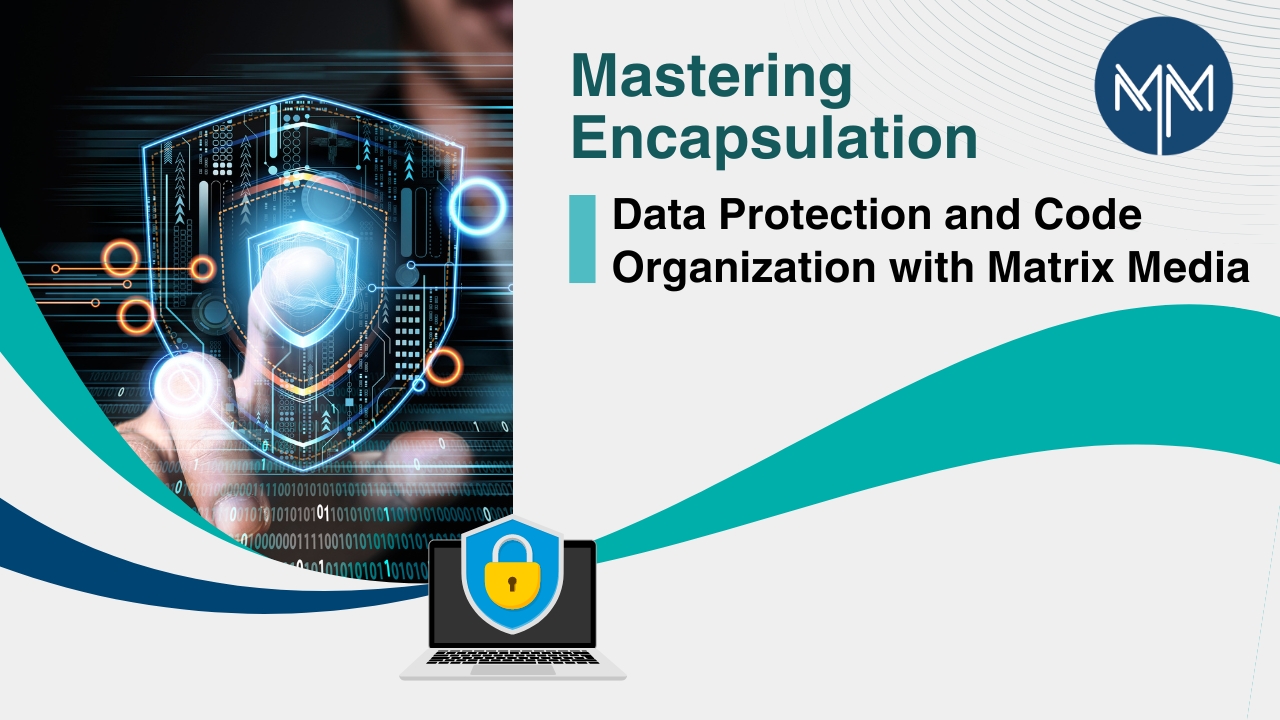The software development life cycle has changed expeditiously over the past few years. In this evolving scenario, encapsulation has become a notable factor among developers. This is because encapsulation is a fundamental principle of object-oriented programming (OOP) that fosters powerful, maintainable, and secure code.
At Matrix Media Solutions, we understand the significance of mastering encapsulation for effective data protection and code organization. At its core, encapsulation refers to the bundling of data (variables) and methods (functions) that operate on the data within a single unit, usually a class. This effective method provides controlled and secure interactions by limiting direct access to an item and concealing its internal state.
Let’s explore how encapsulation enhances code organization, data protection, and scalability and why it is essential for developers and businesses alike. We use encapsulation to provide specialized software solutions that are scalable, effective, and safe.

Defining encapsulation
One of the four pillars of object-oriented programming, along with abstraction, polymorphism, and inheritance, is encapsulation. It offers a technique to limit access to certain data inside an object, guaranteeing that the data can only be altered under rigorous supervision.
Encapsulation can be described as the process of:
- Hiding the internal state of an object from the outside world.
- Exposing only necessary functionalities via public methods to manipulate the object’s internal state.
For instance, rather than allowing direct access to a class’s variables, we encapsulate them as private and provide getter and setter methods to interact with them. This ensures that only valid data is processed by the object, preventing unauthorized changes and ensuring system stability.
Why does encapsulation matter?
Encapsulation delivers several key advantages, all of which contribute to better code organization, data security, and flexibility:
- Data Protection and Security
In a world where data breaches and cyber threats are commonplace, protecting sensitive information becomes significantly important. Encapsulation shields the internal details of an object, making it difficult for unauthorized parties to tamper with or access critical data.
By restricting direct access to variables, we minimize the risk of unintended data manipulation. This reduces the attack surface for malicious actors and ensures that the system behaves as expected, even under unforeseen circumstances. Encapsulation thus plays a significant role in safeguarding software integrity.
- Improved Code Maintainability
Software projects grow in complexity over time, often requiring changes to meet new business requirements. Encapsulation makes code more modular and easier to maintain by decoupling the internal workings of an object from its external interactions. Developers can modify the internal implementation of a class without affecting the other parts of the application.
For instance, you can update the internal logic of the ‘Employee’ class without changing the interface exposed by its public methods. This separation of concerns keeps code more manageable, reducing the potential for bugs and enabling developers to focus on enhancements without fear of breaking other parts of the system.
- Encourages Code Reusability
Encapsulation encourages code reuse when used properly. Modular classes that may be applied to many projects or applications can be made by developers. Other developers can more easily integrate these self-contained classes without having to comprehend their inner workings because they simply expose the pertinent methods needed to deal with the data.
Encapsulated objects can act as building blocks for bigger, more complicated systems, which promotes team cooperation and speeds up development.
- Enhances Flexibility and Scalability
The ability to modify object data processing and storage without affecting the system as a whole is made possible by encapsulation. Encapsulation enables developers to make internal enhancements, including refining code, updating validation logic, or optimizing algorithms, without changing the exterior interface when business requirements change.
Due to this degree of abstraction, software systems are better equipped to adjust to changing needs and grow and change as the company does.
- Improved Debugging and Testing
By limiting the range of problems, encapsulation makes debugging easier. Any problems resulting from incorrect data handling are frequently confined within the class since encapsulated objects restrict access to their internal state, which makes finding and fixing flaws simpler.
Since encapsulated code offers distinct and well-defined points of interaction, testing also becomes more effective. Developers may make sure the internal logic functions as intended without getting bogged down in extraneous details by testing the public methods that a class exposes.

Best Practices for Mastering Encapsulation
At Matrix Media Solutions, we focus on applying best practices to make the most out of encapsulation. Here are some tips we implement to ensure that our code is both efficient and secure:
- Make Data Private: Declare variables as private wherever possible, especially for sensitive information. Use getter and setter methods to provide controlled access to the data. This prevents unauthorized modifications and keeps your internal state secure.
- Validate Inputs: Ensure that all inputs to setter methods are validated before they are assigned to variables. This can prevent issues like incorrect data entry or security vulnerabilities caused by improper user input.
- Use Property Decorators: In some cases, you may want to make getter and setter methods simpler and more Pythonic. You can use property decorators to achieve this, providing a cleaner and more intuitive interface for accessing and modifying data.
- Keep Methods Focused: Each method should have a single responsibility, making the code easier to read, test, and maintain. Avoid packing multiple responsibilities into one method, as this can lead to confusion and bugs.
- Hide Implementation Details: Always abstract away complex implementation details from users. Only expose methods that are necessary for external interaction. This makes the code cleaner and easier to work with while maintaining security.
Encapsulation in Practice at Matrix Media Solutions
At Matrix Media Solutions, we leverage encapsulation across a wide range of projects, from mobile app development to complex enterprise solutions. Our development approach focuses on building modular, secure, and scalable systems that protect sensitive data while ensuring optimal performance.
Whether we’re developing a fintech application, an e-commerce platform, or an IoT solution, encapsulation remains a key factor in our coding standards. By mastering encapsulation, we offer our clients secure, maintainable, and future-proof software solutions.
Our expert team can assist you with:
- Code Reviews: Analyze your existing code to identify areas where encapsulation can be improved.
- Training and Workshops: Delivering tailored training programs to help your team understand and apply encapsulation effectively.
- Consulting Services: Providing expert guidance on designing encapsulated classes and systems.
Conclusion
Mastering encapsulation is vital for software developers who want to build secure, maintainable, and scalable applications. At Matrix Media Solutions, we prioritize encapsulation as a core element of our software development practices, helping businesses protect their data and ensure long-term success.
By adopting encapsulation best practices, we offer solutions that not only meet current needs but are also adaptable to future challenges.
Ready to improve your software’s security and maintainability?
Let Matrix Media Solutions help you master encapsulation for a more organized and protected codebase.


 June 06, 2022
June 06, 2022

